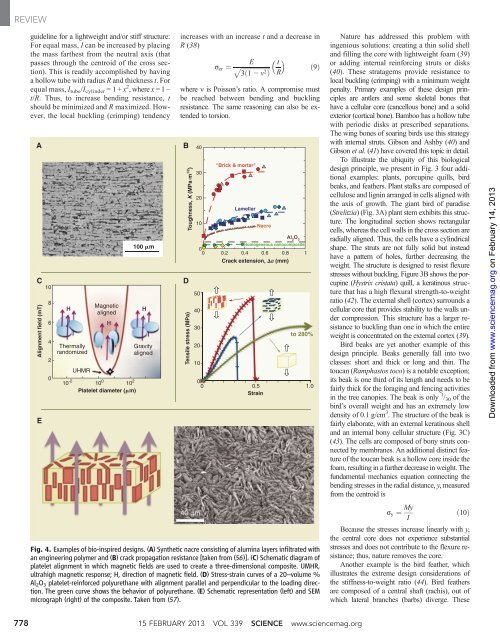et al.
et al.
et al.
You also want an ePaper? Increase the reach of your titles
YUMPU automatically turns print PDFs into web optimized ePapers that Google loves.
REVIEW<br />
778<br />
guideline for a lightweight and/or stiff structure:<br />
For equ<strong>al</strong> mass, I can be increased by placing<br />
the mass farthest from the neutr<strong>al</strong> axis (that<br />
passes through the centroid of the cross section).<br />
This is readily accomplished by having<br />
a hollow tube with radius R and thickness t. For<br />
equ<strong>al</strong> mass, Itube/Icylinder =1+x 2 ,wherex =1–<br />
t/R. Thus, to increase bending resistance, t<br />
should be minimized and R maximized. However,<br />
the loc<strong>al</strong> buckling (crimping) tendency<br />
A B<br />
C<br />
Alignment field (mT)<br />
E<br />
10<br />
8<br />
6<br />
4<br />
2<br />
0<br />
Therm<strong>al</strong>ly<br />
randomized<br />
10 -2<br />
10<br />
Platel<strong>et</strong> diam<strong>et</strong>er (m)<br />
2<br />
10 0<br />
100 m<br />
Magn<strong>et</strong>ic<br />
H H<br />
<strong>al</strong>igned<br />
UHMR<br />
H<br />
Gravity<br />
<strong>al</strong>igned<br />
increaseswithanincreas<strong>et</strong> and a decrease in<br />
R (38)<br />
scr ¼<br />
E<br />
ffiffiffiffiffiffiffiffiffiffiffiffiffiffiffiffiffiffiffi<br />
3ð1 − v2 p<br />
Þ<br />
t<br />
R<br />
ð9Þ<br />
where n is Poisson’s ratio. A compromise must<br />
be reached b<strong>et</strong>ween bending and buckling<br />
resistance. The same reasoning can <strong>al</strong>so be extended<br />
to torsion.<br />
Toughness, K (MPa m 1/2 )<br />
D<br />
Tensile stress (MPa)<br />
40<br />
30<br />
20<br />
10<br />
50<br />
40<br />
30<br />
20<br />
10<br />
0<br />
0<br />
"Brick & mortar"<br />
Lamellar<br />
Nacre<br />
Al2O3 Homogeneous nanocomposite<br />
0.2 0.4 0.6 0.8 1<br />
Crack extension, a (mm)<br />
to 280%<br />
0<br />
0 0.5<br />
Strain<br />
1.0<br />
Fig. 4. Examples of bio-inspired designs. (A) Synth<strong>et</strong>ic nacre consisting of <strong>al</strong>umina layers infiltrated with<br />
an engineering polymer and (B) crack propagation resistance [taken from (56)]. (C)Schematicdiagramof<br />
platel<strong>et</strong> <strong>al</strong>ignment in which magn<strong>et</strong>ic fields are used to create a three-dimension<strong>al</strong> composite. UMHR,<br />
ultrahigh magn<strong>et</strong>ic response; H, direction of magn<strong>et</strong>ic field. (D) Stress-strain curves of a 20–volume %<br />
Al2O3 platel<strong>et</strong>-reinforced polyur<strong>et</strong>hane with <strong>al</strong>ignment par<strong>al</strong>lel and perpendicular to the loading direction.<br />
The green curve shows the behavior of polyur<strong>et</strong>hane. (E) Schematic representation (left) and SEM<br />
micrograph (right) of the composite. Taken from (57).<br />
15 FEBRUARY 2013 VOL 339 SCIENCE www.sciencemag.org<br />
Nature has addressed this problem with<br />
ingenious solutions: creating a thin solid shell<br />
and filling the core with lightweight foam (39)<br />
or adding intern<strong>al</strong> reinforcing struts or disks<br />
(40). These stratagems provide resistance to<br />
loc<strong>al</strong> buckling (crimping) with a minimum weight<br />
pen<strong>al</strong>ty. Primary examples of these design principles<br />
are antlers and some skel<strong>et</strong><strong>al</strong> bones that<br />
have a cellular core (cancellous bone) and a solid<br />
exterior (cortic<strong>al</strong> bone). Bamboo has a hollow tube<br />
with periodic disks at prescribed separations.<br />
The wing bones of soaring birds use this strategy<br />
with intern<strong>al</strong> struts. Gibson and Ashby (40) and<br />
Gibson <strong>et</strong> <strong>al</strong>.(41) have covered this topic in d<strong>et</strong>ail.<br />
To illustrate the ubiquity of this biologic<strong>al</strong><br />
design principle, we present in Fig. 3 four addition<strong>al</strong><br />
examples: plants, porcupine quills, bird<br />
beaks, and feathers. Plant st<strong>al</strong>ks are composed of<br />
cellulose and lignin arranged in cells <strong>al</strong>igned with<br />
the axis of growth. The giant bird of paradise<br />
(Strelitzia) (Fig. 3A) plant stem exhibits this structure.<br />
The longitudin<strong>al</strong> section shows rectangular<br />
cells, whereas the cell w<strong>al</strong>ls in the cross section are<br />
radi<strong>al</strong>ly <strong>al</strong>igned. Thus, the cells have a cylindric<strong>al</strong><br />
shape. The struts are not fully solid but instead<br />
have a pattern of holes, further decreasing the<br />
weight. The structure is designed to resist flexure<br />
stresses without buckling. Figure 3B shows the porcupine<br />
(Hystrix cristata) quill, a keratinous structure<br />
that has a high flexur<strong>al</strong> strength-to-weight<br />
ratio (42). The extern<strong>al</strong> shell (cortex) surrounds a<br />
cellular core that provides stability to the w<strong>al</strong>ls under<br />
compression. This structure has a larger resistance<br />
to buckling than one in which the entire<br />
weight is concentrated on the extern<strong>al</strong> cortex (39).<br />
Bird beaks are y<strong>et</strong> another example of this<br />
design principle. Beaks gener<strong>al</strong>ly f<strong>al</strong>l into two<br />
classes: short and thick or long and thin. The<br />
toucan (Ramphastos toco) is a notable exception;<br />
its beak is one third of its length and needs to be<br />
fairly thick for the foraging and fencing activities<br />
in the tree canopies. The beak is only 1 /30 of the<br />
bird’s over<strong>al</strong>l weight and has an extremely low<br />
density of 0.1 g/cm 3 . The structure of the beak is<br />
fairly elaborate, with an extern<strong>al</strong> keratinous shell<br />
and an intern<strong>al</strong> bony cellular structure (Fig. 3C)<br />
(43). The cells are composed of bony struts connected<br />
by membranes. An addition<strong>al</strong> distinct feature<br />
of the toucan beak is a hollow core inside the<br />
foam, resulting in a further decrease in weight. The<br />
fundament<strong>al</strong> mechanics equation connecting the<br />
bending stresses in the radi<strong>al</strong> distance, y,measured<br />
from the centroid is<br />
sy ¼ My<br />
ð10Þ<br />
I<br />
Because the stresses increase linearly with y,<br />
the centr<strong>al</strong> core does not experience substanti<strong>al</strong><br />
stresses and does not contribute to the flexure resistance;<br />
thus, nature removes the core.<br />
Another example is the bird feather, which<br />
illustrates the extreme design considerations of<br />
the stiffness-to-weight ratio (44). Bird feathers<br />
are composed of a centr<strong>al</strong> shaft (rachis), out of<br />
which later<strong>al</strong> branches (barbs) diverge. These<br />
on February 14, 2013<br />
www.sciencemag.org<br />
Downloaded from





